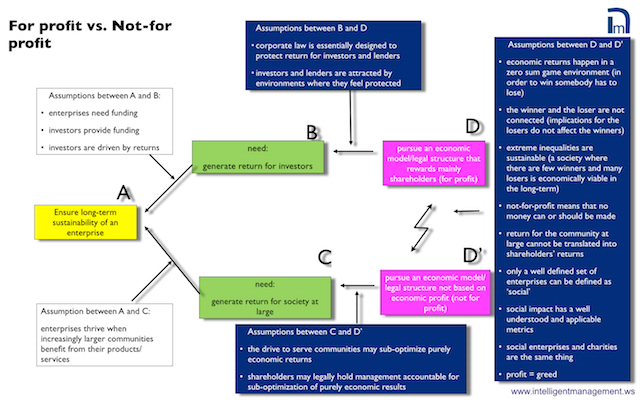 When you think of making a profit versus doing good as a conflict, you can quickly get to the root of the problem. Much of it has to do with the way we think about what profit is. When we challenge our understanding of profit, all kinds of new possibilities arise. How do we do that?
When you think of making a profit versus doing good as a conflict, you can quickly get to the root of the problem. Much of it has to do with the way we think about what profit is. When we challenge our understanding of profit, all kinds of new possibilities arise. How do we do that?
The “for profit”assumptions
We’ve been asked to talk more about what ‘Social Enterprise’ means. Cause and effect logic is a powerful means of investigation that we use regularly not just to discuss issues but also to identify plausible solutions. So let’s look at “profit” versus “doing good” as a conflict and see where that takes us. In order to do so, we have to be willing to challenge a series of assumptions (mental models) around the question.
When we set up an organization and we want to ensure its long-term sustainability, we have to decide first of all what the purpose of the organization is. If its purpose is profit, then the organization has to protect a precise need, i.e. to generate return for investors. If that is the need and we make the following assumptions:
- corporate law is essentially designed to protect return for investors and lenders
- investors and lenders are attracted by environments where they feel protected
then what we want to do is: “Pursue an economic model/legal structure that rewards mainly shareholders (for profit).
The “not for profit” assumptions
Vice versa, if our organization is not profit based it’s because we have a different purpose and need. We can verbalize the need that a not-for profit organization must protect as : generate return for society at large. If we then make the following assumptions:
- the drive to serve communities may sub-optimize purely economic returns
- shareholders may legally hold management accountable for sub-optimization of purely economic results
then we want something very different that will allow us to pursue freely our purpose. We want to pursue an economic model/legal structure not based on economic profit (not for profit).
But what if we want to do good AND make money?
Is there no alternative to “for profit” vs. “not-for profit”? Do we have to choose one or the other? Why do we even think these two purposes are in conflict?
It’s all to do with how we think about it, and this thinking is evolving every day. We can quickly understand why we might be stuck in this conflict if we look at a set of assumptions that keep us stuck and make us yo-yo between the two positions of for profit versus not-for profit. These assumptions are nothing other than mental models or limiting beliefs; if we can successfully challenge them then we open up a whole new space for new solutions.
We have verbalized those key assumptions that need to be challenged (other people will find more) as:
- economic returns happen in a zero sum game environment (in order to win somebody has to lose)
- the winner and the loser are not connected (implications for the losers do not affect the winners)
- extreme inequalities are sustainable (a society where there are few winners and many losers is economically viable in the long-term)
- not-for-profit means that no money can or should be made
- return for the community at large cannot be translated into shareholders’ returns
- only a well defined set of enterprises can be defined as ‘social’
- social impact has a well understood and applicable metrics
- social enterprises and charities are the same thing
- profit = greed
Changing the mindset
The mindset that separates “for profit” from “not-for-profit” is rooted in the belief that there is one pie, and that if I take a slice of the pie, then no one else can have that slice. It’s mine, unless I decide to give some of it away. Sharing the pie with others is an activity that has to be funded because it produces no other benefit.
This has been the prevailing mindset up until the last century and it has been reinforced by the way organizations are legally structured. In our next post we’ll look at how the Social Enterprise can be a solution to shift us towards a more liberating way of creating and managing our organizations.
Below we have captured the “conflict” using a Thinking Process Tool from the Theory of Constraints called the Conflict Cloud. Click to enlarge.
About the Author
Angela Montgomery Ph.D. is Partner and Co-founder of Intelligent Management, founded by Dr. Domenico Lepore. Angela’s new business novel+ website The Human Constraint looks at how Deming and the Theory of Constraints can create the organization of the future, based on collaboration, network and social innovation.






Leave a Reply